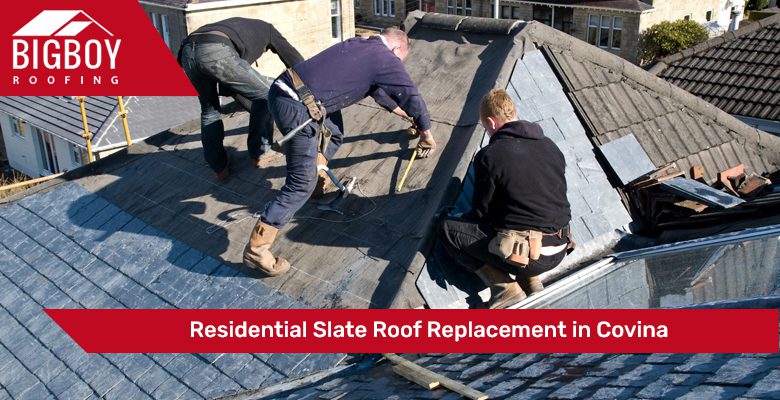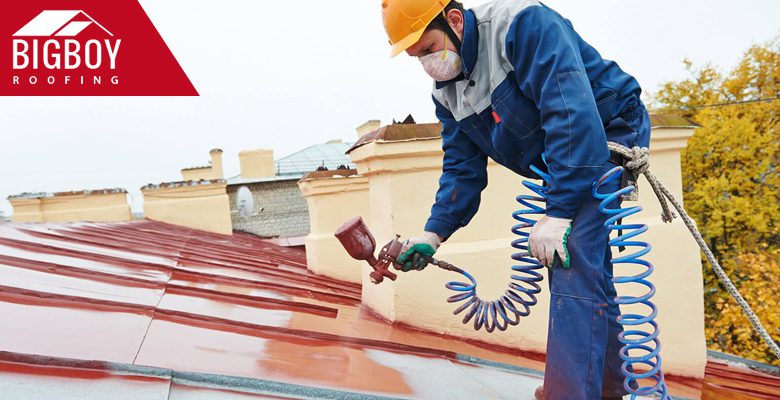Residential Slate Roof Replacement
If you are considering a residential slate roof replacement, we understand the weight of your decision. Choosing the right materials and ensuring a seamless process can feel overwhelming. That’s why we’re here to lend a compassionate hand.

In this blog post, we’ll provide invaluable insights to help you navigate getting a roof replacement. From selecting the perfect slate tiles to finding reputable contractors, join us as we guide you through every step of this important home improvement project.
Common Reasons for Residential Slate Roof Replacement
There are several common reasons homeowners choose to replace their residential slate roofs with our Covina roofing experts. Here are some of the most prevalent reasons:
I. Age and Wear: Slate roofs are known for their durability but can show signs of aging and wear over time. After several decades, the slate tiles may become brittle, crack, or develop leaks.
II. Damage from Weather: Extreme weather conditions such as hailstorms, heavy winds, or falling tree branches can cause significant damage to slate roofs. Severe impacts can crack or break individual tiles, compromising the roof’s integrity.
III. Poor Installation or Repairs: Improper installation or previous repair work done by inexperienced contractors can lead to ongoing issues with a slate roof. If the installation was not done correctly or the repairs were ineffective, it can result in recurring leaks or other problems.
IV. Insufficient Maintenance: Failure to perform necessary maintenance tasks such as cleaning gutters, removing debris, or promptly addressing minor issues can lead to more significant problems.
V. Outdated or Incompatible Design: Homeowners may choose to replace their slate roofs if they desire a different aesthetic or outdated design.
Causes of Residential Slate Roof Damage
Residential slate roofs can be durable and long-lasting but susceptible to damage under certain conditions. Here are some common causes:
| Causes | Description |
| Impact Damage | One of the primary causes of slate roof damage is the impact of falling objects like tree branches, large hailstones, or debris carried by strong winds. These impacts can result in cracks or breaks in the slate tiles. |
| Freeze-Thaw Cycles | When water seeps into cracks or pores in the slate tiles and subsequently freezes, it expands. This expansion can cause fractures or delamination of the tiles over time, resulting in cumulative damage to the slate. |
| Roof Traffic and Foot Traffic | Walking or standing on a slate roof can cause damage, particularly if done improperly or by inexperienced individuals. |
| Moss, Algae, and Lichen Growth | In moist and shaded environments, moss, algae, and lichen can grow on the surface of slate tiles. While these organisms may not directly damage the slate, they can retain moisture and promote the growth of roots or spores that penetrate the tile surface. |
How Is Residential Slate Roof Replacement Done?
Residential slate roof replacement by our roofing experts is a complex process that requires expertise and proper planning. Here is a general overview of how it is typically done:

I. Inspection and Preparation: The first step is inspecting the existing slate roof. Our professional roofing contractor will assess the slate tiles’ condition and the underlying structure and identify any areas that require repair or replacement. The contractor will also determine the project’s scope, including the number of slate tiles needed.
II. Material Selection: Once the inspection is complete, you and the contractor will discuss material options for the replacement slate tiles. Choosing slate tiles that match the existing ones in size, color, texture, and quality is important to maintain the roof’s aesthetic appeal.
III. Removal of Existing Slate: The next step is to remove the existing slate tiles from the roof. This is typically done by carefully prying or sliding out the individual tiles, taking care not to damage the underlying structure.
IV. Repairs and Replacement: During the removal process, the contractor will identify any damaged or deteriorated areas of the roof structure, such as the decking or underlayment. These areas will be repaired or replaced to ensure a solid foundation for the new slate roof.
V. Installation of New Slate: The contractor will install the new slate tiles once the necessary repairs are completed. Each tile is carefully placed and secured using appropriate fasteners, such as copper nails or hooks, to ensure stability and proper alignment.
VI. Flashing and Finishing Touches: Proper flashing installation around chimneys, vents, skylights, and other roof penetrations is crucial to prevent water infiltration. The contractor will install or replace the flashing and ensure a watertight seal.
Schedule a call with our roofing contractors today!
You can proactively address any underlying concerns by booking a consultation, preventing costly repairs. It’s an investment in the long-term health of your roof and home.
FAQs
When is it time to consider residential slate roof replacement?
It’s time to consider slate roof replacement when the roof shows signs of significant wear, extensive damage, persistent leaks, or is nearing the end of its lifespan (typically around 75-100 years).
Can individual damaged slate tiles be repaired instead of replacing the entire roof?
In some cases, individual damaged slate tiles can be repaired. However, if the roof has widespread damage or is nearing the end of its lifespan, a full replacement may be more cost effective and provide better long-term results.
What are the advantages of choosing slate for residential roofing?
Slate offers exceptional durability, fire resistance, and an aesthetically pleasing appearance. It is also low maintenance and can enhance a home’s value and curb appeal.
How long does the residential slate roof replacement process typically take?
The duration of slate roof replacement can vary depending on factors such as the roof’s size, the project’s complexity, and weather conditions. It can take several weeks to complete the entire process.

